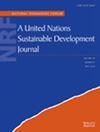了解中国能源消费的影响因素:地理空间与经济 "新常态 "的双重视角
IF 3.5
4区 社会学
Q2 ENVIRONMENTAL SCIENCES
引用次数: 0
摘要
中国经济已步入 "新常态",对能源利用效率提出了更高的要求。与此同时,中国能源消费与经济发展的空间分布呈现出明显的不平衡性,使得实现区域能源配置效率帕累托最优的努力变得更加复杂。针对这一问题,本研究采用指数分解模型,从经济 "新常态 "和地理空间的双重视角探讨了中国能源消费影响因素的异质性。研究结果表明(1)能源强度效应对地区能源消费增长的抑制作用存在分化,广东、江苏等省份的抑制作用较强,海南、青海等省份的抑制作用较弱。生活水平效应对地区能源消费增长的促进作用也存在差异,江苏、山东等省份的促进作用较强,而海南、青海等省份的促进作用较弱。(2)人口规模效应对区域能源消费增长的作用方向不一致,广东、浙江等省份具有促进作用,且作用效果较强,相反,黑龙江、吉林、甘肃等省份具有抑制作用。(3)在经济 "新常态 "后期,四地能源强度效应、生活水平效应和人口规模效应对能源消费增长的影响呈减弱趋势,且这种减弱趋势在东北地区更为明显。本研究拓展了能源消费影响因素的理论研究,为我国政府在经济 "新常态 "和地域因素下协调区域能源配置提供了实践指导。本文章由计算机程序翻译,如有差异,请以英文原文为准。
Understanding the influencing factors of energy consumption in China: A dual perspective of geographical space and economic “new normal”
China's economy has transtioned into the “new normal”, which demands higher standards for energy utilization efficiency. Meanwhile, the spatial distribution of China's energy consumption and economic development exhibits a significant imbalance, complicating efforts to achieve Pareto optimization of regional energy allocation efficiency. Addressing this issue, this study explores the heterogeneity of the factors influencing energy consumption in China from the dual perspectives of economic “new normal” and geographic space, using an exponential decomposition model. The results of the study show that: (1) the inhibitory effect of the energy intensity effect on the growth of regional energy consumption is differentiated, with stronger inhibitory effects in Guangdong, Jiangsu and other provinces, and weaker inhibitory effects in Hainan, Qinghai, and other provinces. Living standard effect on the regional energy consumption growth of the promotion of the effect also has differences, Jiangsu, Shandong and other provinces of the promotion of the effect is stronger, while Hainan, Qinghai, and other provinces of the promotion of the effect is weaker. (2) Population size effect on regional energy consumption growth is not consistent in the direction of the role of Guangdong, Zhejiang, and other provinces have a promotional effect and the role of the effect of the stronger, on the contrary, the provinces of Heilongjiang, Jilin, and Gansu has an inhibitory effect. (3) In the late stage of the economic “new normal”, the effects of energy intensity effect, living standard effect and population size effect on the growth of energy consumption in the four regions show a weakening trend, and this weakening trend is more obvious in the northeast region. This study expands theoretical research on factors affecting energy consumption and offers practical guidance for China's government to coordinate regional energy allocation under the economic “new normal” and geographical considerations.
求助全文
通过发布文献求助,成功后即可免费获取论文全文。
去求助
来源期刊

Natural Resources Forum
环境科学-环境科学
CiteScore
6.10
自引率
0.00%
发文量
24
审稿时长
>36 weeks
期刊介绍:
Natural Resources Forum, a United Nations Sustainable Development Journal, focuses on international, multidisciplinary issues related to sustainable development, with an emphasis on developing countries. The journal seeks to address gaps in current knowledge and stimulate policy discussions on the most critical issues associated with the sustainable development agenda, by promoting research that integrates the social, economic, and environmental dimensions of sustainable development. Contributions that inform the global policy debate through pragmatic lessons learned from experience at the local, national, and global levels are encouraged.
The Journal considers articles written on all topics relevant to sustainable development. In addition, it dedicates series, issues and special sections to specific themes that are relevant to the current discussions of the United Nations Commission on Sustainable Development (CSD). Articles must be based on original research and must be relevant to policy-making.
Criteria for selection of submitted articles include:
1) Relevance and importance of the topic discussed to sustainable development in general, both in terms of policy impacts and gaps in current knowledge being addressed by the article;
2) Treatment of the topic that incorporates social, economic and environmental aspects of sustainable development, rather than focusing purely on sectoral and/or technical aspects;
3) Articles must contain original applied material drawn from concrete projects, policy implementation, or literature reviews; purely theoretical papers are not entertained.
 求助内容:
求助内容: 应助结果提醒方式:
应助结果提醒方式:


